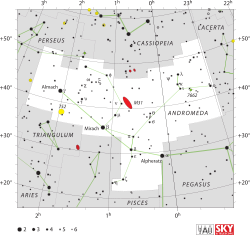Rho Andromedae
| Observation data Epoch J2000.0 Equinox J2000.0 | |
|---|---|
| Constellation | Andromeda |
| Right ascension | 00h 21m 07.26896s[1] |
| Declination | +37° 58′ 06.9727″[1] |
| Apparent magnitude (V) | +5.19[2] |
| Characteristics | |
| Spectral type | F5IV-V[3] |
| U−B color index | +0.039[2] |
| B−V color index | +0.424[2] |
| Astrometry | |
| Radial velocity (Rv) | +10.4±0.6[4] km/s |
| Proper motion (μ) | RA: +57.599[1] mas/yr Dec.: –38.378[1] mas/yr |
| Parallax (π) | 20.1874 ± 0.1179 mas[1] |
| Distance | 161.6 ± 0.9 ly (49.5 ± 0.3 pc) |
| Absolute magnitude (MV) | +1.73[5] |
| Details | |
| Radius | 3.37+0.07 −0.03[1] R☉ |
| Luminosity | 17.93±0.13[1] L☉ |
| Surface gravity (log g) | 3.84[6] cgs |
| Temperature | 6,471+25 −66[1] K |
| Metallicity [Fe/H] | –0.09[6] dex |
| Rotational velocity (v sin i) | 44[6] km/s |
| Age | 1.3[5] Gyr |
| Other designations | |
| Database references | |
| SIMBAD | data |
Rho Andromedae, Latinized from ρ Andromedae, is the Bayer designation for a star in the northern constellation of Andromeda. It has an apparent visual magnitude of +5.19,[2] which, according to the Bortle Dark-Sky Scale, is bright enough to be seen with the naked eye from dark suburban skies. Based upon parallax measurements, this star is at a distance of approximately 162 light-years (50 parsecs) from the Sun.[1] It is drifting further away with a radial velocity of +10 km/s.[4]
The stellar classification of this star is F5IV-V,[3] showing mixed spectral features of a main sequence and subgiant stage. It is about 1.3[5] billion years old with 3.4[1] times the girth of the Sun and is spinning with a projected rotational velocity of 44 km/s.[6] The outer envelope is radiating around 18 times the luminosity of the Sun from its photosphere at an effective temperature of 6,471 K,[1] giving it the yellow-white hue of an F-type star.[8] X-ray emissions were detected from this star during the EXOSAT mission.[9]
Naming[edit]
In Chinese, 天廄 (Tiān Jiù), meaning Celestial Stable, refers to an asterism consisting of ρ Andromedae, θ Andromedae and σ Andromedae. Consequently, the Chinese name for ρ Andromedae itself is 天廄二 (Tiān Jiù èr, English: the Second Star of Celestial Stable.)[10]
References[edit]
- ^ a b c d e f g h i j k Brown, A. G. A.; et al. (Gaia collaboration) (August 2018). "Gaia Data Release 2: Summary of the contents and survey properties". Astronomy & Astrophysics. 616. A1. arXiv:1804.09365. Bibcode:2018A&A...616A...1G. doi:10.1051/0004-6361/201833051. Gaia DR2 record for this source at VizieR.
- ^ a b c d Breger, M. (March 1968), "UBV and narrow-band UVBY photometry of bright stars", Astronomical Journal, 73: 84–85, Bibcode:1968AJ.....73...84B, doi:10.1086/110602.
- ^ a b Gray, R. O.; et al. (April 2001), "The Physical Basis of Luminosity Classification in the Late A-, F-, and Early G-Type Stars. I. Precise Spectral Types for 372 Stars", The Astronomical Journal, 121 (4): 2148–2158, Bibcode:2001AJ....121.2148G, doi:10.1086/319956.
- ^ a b Gontcharov, G. A. (November 2006), "Pulkovo Compilation of Radial Velocities for 35495 Hipparcos stars in a common system", Astronomy Letters, 32 (11): 759–771, arXiv:1606.08053, Bibcode:2006AstL...32..759G, doi:10.1134/S1063773706110065, S2CID 119231169.
- ^ a b c Nordström, B.; et al. (May 2004), "The Geneva-Copenhagen survey of the Solar neighbourhood. Ages, metallicities, and kinematic properties of ˜14 000 F and G dwarfs", Astronomy and Astrophysics, 418: 989–1019, arXiv:astro-ph/0405198, Bibcode:2004A&A...418..989N, doi:10.1051/0004-6361:20035959, S2CID 11027621.
- ^ a b c d Balachandran, Suchitra (May 1, 1990). "Lithium depletion and rotation in main-sequence stars". Astrophysical Journal, Part 1. 354: 310–332. Bibcode:1990ApJ...354..310B. doi:10.1086/168691.
- ^ "* rho And -- Star". SIMBAD. Centre de données astronomiques de Strasbourg. Retrieved 2012-06-24.
- ^ "The Colour of Stars", Australia Telescope, Outreach and Education, Commonwealth Scientific and Industrial Research Organisation, December 21, 2004, archived from the original on 2013-12-03, retrieved 2012-01-16.
- ^ Gondoin, P.; Mangeney, A.; Praderie, F. (March 1987), "Solar-type giants - New X-ray detections from EXOSAT observations", Astronomy and Astrophysics, 174 (1–2): 187–196, Bibcode:1987A&A...174..187G.
- ^ (in Chinese) AEEA (Activities of Exhibition and Education in Astronomy) 天文教育資訊網 2006 年 5 月 18 日

